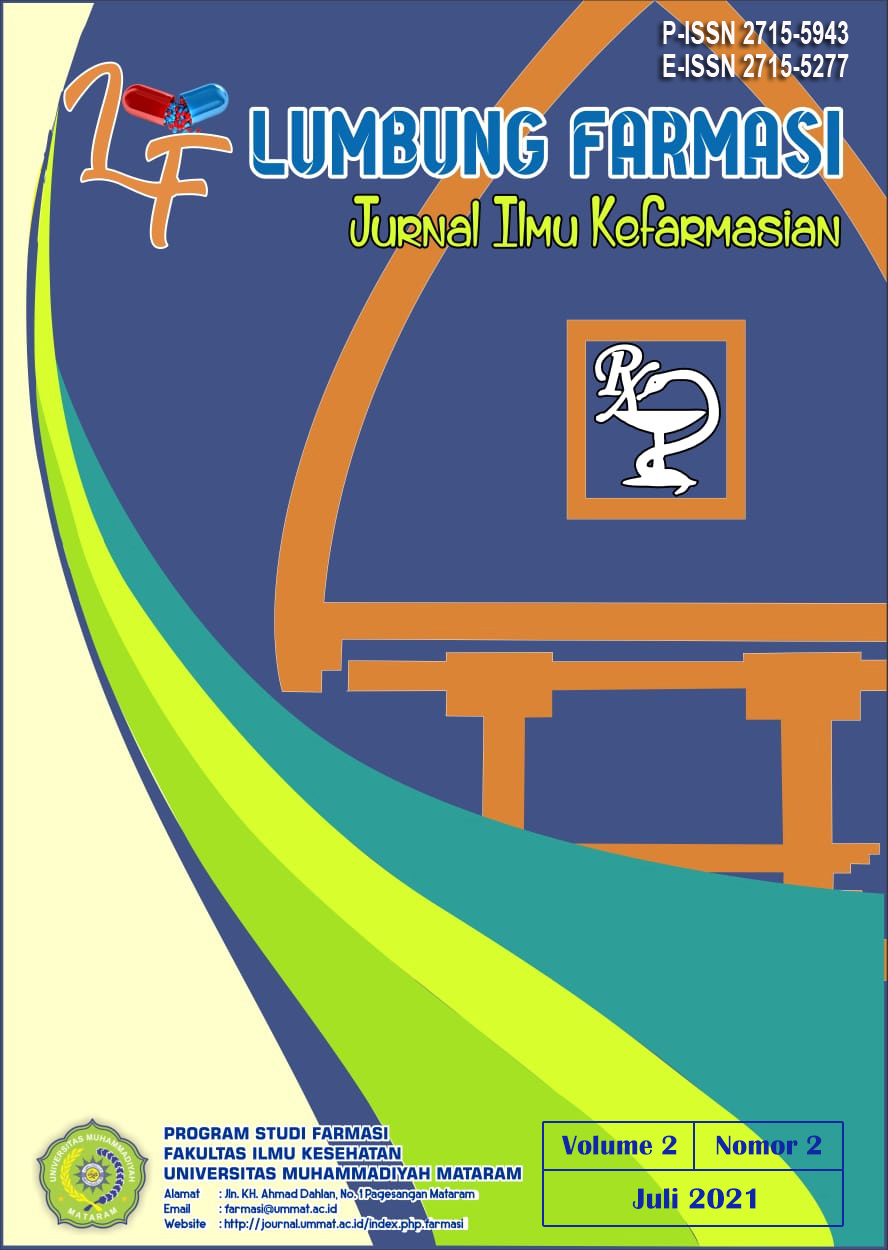Uji Kualitatif Aktivitas Antioksidan Ekstrak Etanol Propolis
DOI:
https://doi.org/10.31764/lf.v2i2.5499Keywords:
Antioxidant, Propolis, DPPHAbstract
ABSTRAK
Propolis adalah zat yang terdiri dari campuran resin, serbuk sari dan lilin tanaman yang dikumpulkan oleh lebah madu. Selain itu propolis mengandung senyawa metabolit sekunder seperti flavonoid yang berpotensi sebagai antioksidan. Penelitian ini dilakukan dengan tujuan untuk mengetahui ada atau tidaknya potensi antioksidan dari ekstrak etanol propolis. Uji kualitatif aktivitas antioksidan ekstrak etanol propolis dilakukan menggunakan pereaksi DPPH (2.2-diphenyl-1-picrylhydrazyl). Hasil penelitian menunjukkan bahwa terjadi perubahan warna larutan DPPH dari unggu menjadi kuning pada ekstrak etanol propolis panen 6 bulan dan 1 tahun. Berdasarkan hasil tersebut dapat disimpulkan bahwa ekstrak etanol propolis panen 6 bulan dan 1 tahun memiliki potensi sebagai antioksidan.
Â
Kata kunci: Antioksidan; Propolis; DPPH.
ABSTRACT
Propolis is a substance consisting of a mixture of resin, pollen, and plant wax collected by honeybees. In addition, propolis contains secondary metabolite compounds such as flavonoids that have the potential as antioxidants. This research was conducted to know the potential or potential antioxidants of propolis ethanol extract. A qualitative test of antioxidant activity of propolis ethanol extract was conducted using DPPH reagents (2.2-diphenyl-1-picrylhydrazyl). The results showed that there was a discoloration of DPPH solution from Purple to yellow in propolis ethanol extract harvested 6 months and 1 year. Based on these results can be concluded that propolis ethanol extract harvest 6 months and 1 year has the potential as an antioxidant.
Keyword: Antioxidant; Propolis; DPPH
References
Astiti Asih, I., Ratnayani, K., & Swardana, I. (2012). Isolasi Dan Identifikasi Senyawa Golongan Flavonoid Dari Madu K Elengkeng (Nephelium Longata L.). Jurnal Kimia, 6(1), 72–78.
Bankova, V., Popova, M., & Trusheva, B. (2014). Propolis volatile compounds: Chemical diversity and biological activity: A review. Chemistry Central Journal, 8(1), 1–8.
Dai, J., & Mumper, R. J. (2010). Plant phenolics: Extraction, analysis and their antioxidant and anticancer properties. Molecules, 15(10), 7313–7352.
Dwi, A., & Syam, L. (2017). Kadar Fenolik Total Ekstrak Etanol Daun Kersen (Muntingia Calabura). Jurnal Ilmiah Cendekia Eksakta, 1–8.
Hesti Kurnia, N., & Taufikurohmah, T. (2017). Pengaruh Penambahan Nanosilver Terhadap Aktivitas Antioksidan Nanogold Dalam Meredam Radikal Bebas. UNESA Journal of Chemistry, 6(3), 161–165.
Huang, S., Zhang, C. P., Wang, K., Li, G. Q., & Hu, F. L. (2014). Recent advances in the chemical composition of propolis. Molecules, 19(12), 19610–19632.
Khairunnisa, K., Mardawati, E., & Putri, S. H. (2020). Karakteristik Fitokimia dan Aktivitas Antioksidan Ekstrak Propolis Lebah Trigona Sp. Jurnal Industri Pertanian, 2(1), 124–129.
Mahantesh, S. P., Gangawane, A. K., & Patil, C. S. (2012). Free Radicals , Antioxidants , Diseases and Phytomedicines in Human Health : Future Perspects. World Research Journal of Medicine & Aromatic Plants, 1(1), 6–10.
Nica Dewi, P., Hartiati, A., & Mulyani, S. (2016). Pengaruh Umur Panen Dan Tingkat Maserasi Terhadap Kandungan Kurkumin Dan Aktivitas Antioksidan Ekstrak Kunyit (Curcuma Domestica Val.). Jurnal Rekayasa Dan Manajemen Agroindustri, 4(3), 105–115.
Nn, A. (2015). A Review on the Extraction Methods Use in Medicinal Plants, Principle, Strength and Limitation. Medicinal & Aromatic Plants, 04(03), 3–8.
Pasupuleti, V. R., Sammugam, L., Ramesh, N., & Gan, S. H. (2017). Honey, Propolis, and Royal Jelly: A Comprehensive Review of Their Biological Actions and Health Benefits. Oxidative Medicine and Cellular Longevity, 2017.
Pratama, M., Muflihunna, A., & Octaviani, N. (2018). Analisis Aktivitas Antioksidan Sediaan Propolis Yang Beredar Di Kota Makasar dengan Metode FRAP (Ferric Reducing Antioxidant Power). Jurnal Ilmiah As-Syifaa, 10(1), 11–18.
Qonitah, F., & Ahwan. (2018). Aktivitas Antioksidan Dan Kandungan Fenolik Total Dari Isolat Polar Fraksi Heksana Ekstrak Etanol Daun Sirih (Piper Betle L.). Jurnal Farmasetis, 7(2), 42–46.
Rahmawati, R., Muflihunna, A., & Sarif, L. M. (2016). Analisis Altivitas Antioksidan Produk Sirup Buah mengkudu (Morinda citrifolia L.) Dengan Metode DPPH. Jurnal Fitofarmaka Indonesia, 2(2), 97–101.
Sami, F. J., & Rahimah, S. (2015). Uji Aktivitas Antioksidan Ekstrak Metanol Bunga Brokoli (Brassica oleracea L. var. Italica) Dengan Metode DPPH (2,2 diphenyl-1-picrylhydrazyl) dan Metode ABTS (2,2 azinobis (3-etilbenzotiazolin)-6-asam sulfonat). Jurnal Fitofarmaka Indonesia, 2(2), 107–110.
Thamrin, A., Erwin, & Syafrizal. (2016). Uji Fitokimia, Toksisitas Serta Antioksidan Ekstrak Propolis Pembungkus Madu Lebah Trigona Incisa Dengan Metode 2 , 2- diphenyl -1- picrylhidrazyl (DPPH). Jurnal Kimia Mulawarman, 14(1), 54–60.
Yarlina, V. P., Sumanti, D. M., Sofiah, B., & Mahani. (2020). Kajian Konsentrasi Etanol, Metode Ekstraksi Propolis Dan Karakteristik Ekstrak Propolis Lebah Trigona Sp. Terhadap Aktivitas Antimikroba Escherichia Coli. Jurnal Teknologi & Industri Hasil Pertanian, 25(1), 27–34.
Yulia, R., Azminah, A., Michella, M., & Tanzil, A. (2015). An Assay of Antioxidant Power of Methanolic Extract Various Type of Soybean. Jurnal Sains Farmasi & Klinis, 1(2), 122.

